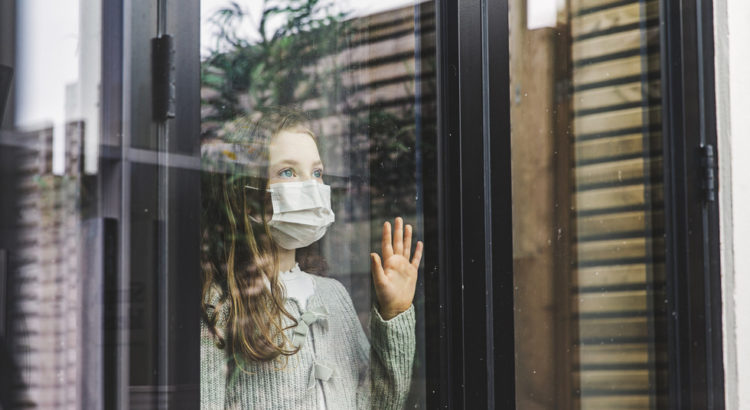Europe / Spain / 05/20/2020 / Author: Miguel Ángel García Vega / Source: https://english.elpais.com/
Half of all job losses since the start of the outbreak have happened to adults under the age of 35, who experts say will face the brunt of the economic fallout from the pandemic.
he coronavirus crisis has stunted the prospects of hundreds of thousands of young people in Spain. While youth is frequently defined as the prime of one’s life encompassing a career, getting a place to live, love and heartbreak, children – for those who choose to have them – studying, traveling, making mistakes, suffering and regret, around 6.5 million Spaniards who were between 20 and 29 in 2008 and are now between 32 and 41 might well focus only on the list’s negatives.
This generation, which represents 14.2% of the population according to Spain’s National Statistics Institute (INE), is facing their second global economic crisis in only 12 years; the economic downturn of 2008 and now the pandemic. Ed è súbito sera. “And suddenly, the night,” as the Italian poet and Nobel Prize winner Salvator Quasimodo put it. No one can deny the rapidly descending gloom.
In April, unemployment among those aged 25 to 29 – the hardest hit demographic – rose by 13.1%. And in the first quarter, unemployment for those under 25 was 33%, two and a half points higher than the last quarter of 2019. The figures released in April paint a bleak picture. Half of job losses – around the 460,000 – since the start of this crisis have been among the under-35s.
Without doubt, instability has come at the worst possible moment. The youngsters who entered the labor market in the middle of the financial crisis between 2008 and 2013 are being hit just when they were starting to get on their feet. “The impact will be huge because young people are starting out in an already very vulnerable situation, characterized by impermanence, and have not yet finished footing the bill of the previous crisis,” says María Ángeles Davia Rodríguez, professor at the University of Castile-La Mancha. “The cost of this bill will depend largely on levels of job security in the face of the pandemic. That is, whether the person can continue to telework or whether they will be faced with intense social contact when they go back to work.”
The consulting firm CEPR Policy estimates that currently only 25.4% of jobs in Spain can safely be done from home – a percentage that could rise to 43% when restrictions are scaled back to a minimum. “There is a divide between young people who are privileged to have jobs that can be done remotely, such as those working in finance or computer science, and those who work in catering or retail with face-to-face contact [with the public],” says David Grusky, director of the Stanford Center on Poverty and Inequality at Stanford University. “These are new forces of injustice.”
Every generation has been defined by traumatic events, which generally generate fear and uncertainty. They are events that change the way people understand the world, and affect the way in which they make decisions and take risks. “Entering the labor market in times of recession has dire and persistent consequences on the wage trajectory of young Spaniards. Its repercussions can last up to a decade,” says Nuria Rodríguez-Planas, professor at the City University of New York.
Along with her colleague Daniel Fernández-Kranz, Rodríguez-Planas has laid out her research on this phenomenon in the article The Perfect Storm: Graduating during a Recession in Segmented Labor Market. “Regarding university graduates, there is a 6.4% reduction [in wages] on average in the first 10 years if the person enters a labor market with 18% unemployment instead of 10%,” she says.
In other demographics, the fallout is worse, with those who have completed high school being hit by a reduction in wages of 10% and those with vocational training, 12.5%.
In April, the number of people unemployed under the age of 25 rose by 31,262 compared to the previous month
Meanwhile, experts from CaixaBank Research say that between 2008 and 2016, the average salary for workers between the ages of 20 and 24 fell by 15%, while those aged 25 to 29 lost 9% of their income.
These figures meant life projects, such as independent living and starting a family, were put on hold; historically, it has been shown that economic insecurity reduces fertility and delays home-making.
Other reports such as Youth Unemployment in Spain, published by the journal Papeles de Economía Española (or Papers on the Spanish Economy), analyzed the lives of young people who are now aged between 36 and 40 – a demographic that, despite having gone through the initial stages of the recession between 2005 and 2012, should have had their lives on track by 2020. Instead, there was something akin to “boomer envy” – a concept coined by novelist Douglas Coupland in the book Generation X, which addresses inequality and the McJobs era of the 1990s in the United States.
According to Maria Ángeles Davia, the study found that the probability of becoming unemployed was significantly higher among those who had lost their job before the age of 30. And the stigma was more intense the longer their experience of unemployment lasted during their youth.
It is reasonable to assume that the frustration of the millennials who are now in that age bracket will be even greater as they have also had to bear the burden of the wage cuts that followed the 2011 labor reforms. “They must feel as though they will never see economic security in their lifetime,” says Markus Gangl, professor of sociology at Goethe University in Frankfurt, Germany.
According to Jason Dorsey, president of the consulting firm The Center for Generational Kinetics, “they’re going to lose wages, jobs and career prospects while older workers try to keep going for longer, thereby limiting future job offers. They will also have to bear much of the tax burden that pays for older people’s benefits.”
Generational comparisons
Deep down, thousands of young people feel that other generations have taken the best and placed barbed wire around the rest. Many envy their parents, who could retire at the age of 60. But that era has long gone. Now, around 60 million jobs in Europe are in jeopardy. The future, according to the McKinsey consultancy firm, will consist of a reduction in paid working hours, a flood of temporary contracts, and permanent lay-offs. And it is young people once more who will be in the eye of the storm as seven million jobs employing 15 to 24-year-olds could go.
“It could be worse if European governments introduce new austerity measures in the coming years to cope with the budgetary pressure created by the crisis,” says Michele Raitano, professor of political economy at the University of La Sapienza in Rome. “And we already know what that means: worse conditions for workers and deep cuts to social spending.”
There is an urgent need to protect jobs. Every job saved keeps productivity and consumption up, reduces dependence on the state and has a positive effect on health and wellbeing. The numbers of job losses must be brought down. It is not enough to flatten this curve. In April, the number of unemployed people under the age of 25 rose by 31,262 compared to the previous month. That’s close to an 11% hike in a country where youth unemployment has held at 40% in some areas, particularly the south, even during prosperity. “The situation of young people was already difficult before the crisis and now they have begun to form part of structural unemployment; that is, chronic unemployment,” says Raquel Llorente Heras, professor of Economics at the Autonomous University of Madrid.
Threats
With thousands of young people on temporary contracts, the threat of what’s around the corner is very real, particularly with regard to how things will play out after the state of alarm. At the end of the coronavirus lockdown, it is possible that “there will be a significant loss of temporary employment,” says Llorente.
So what’s the answer? “One option would be a minimum income that would act as a springboard to access the labor market,” proposes Rafael Doménech, head of economic analysis at BBVA Research. “But it should be designed so that the young person does not come to depend on it, and it should be temporary.” No matter what its dimensions, almost everyone agrees with Llorente that it is “necessary.”
Younger sections of the population must be protected, especially in a world where health and economic crises will become more frequent. According to the International Labor Organization, youth unemployment increased by 7.8 million between 2007 and 2009, while the decade before it had grown on average by just 191,000 per year.
“They [young people] are the least affected by the virus, but will be the most exposed to the economic fallout from the pandemic,” says Stefano Scarpetta, director of employment, labor and social affairs at the Organization for Economic Cooperation and Development (OECD). “In the second phase of the crisis and beyond, attention will have to be paid to how we tackle this inequality through policies that target its source – for example, loopholes in social protection systems and low-skilled youth.” As Jordi Fabregat, a professor at Madrid’s Esade Business School, says, people between 30 and 35 without a good education “are in for a hard time.”
The Covid-19 crisis has interfered with the end of the school year in Spain and complicated access to the labor market for thousands of young people who should graduate or finish their studies this summer. Nobody knows for sure what impact this will have on their future. The situation brings to mind a line from Gabriel García Márquez’s One Hundred Years of Solitude: “The world was so recent that many things lacked names.”
But, according to Carlos Martín, head of the economic department for the CCOO labor union, shattering the expectations of Spain’s youth can be avoided. “We must raise taxes to bring Spain’s fiscal contribution into line with the European average, eliminate the immense flexibility of temporary contracts, which leads to instability, and guarantee access to housing to end the ‘postponed existences’ experienced by the young and the not-so-young,” he says. His proposals include ceilings on rents, taxing empty properties, restricting tourist apartments and creating a protected pool of public housing for rent.
Meanwhile, lawyer Antonio Garrigues Walker believes that things have a way of working out. “Sensationalism should be regarded as practically a crime at the moment,” he says. “I am an optimist. Human beings, particularly young ones, are very resilient and have always been able to adapt. There will have to be changes but not that many. Humanity has lived through other pandemics and got over them.”
That resilience is also flagged up by Josep Mestres, an economist at CaixaBank Research. “Young people are the ones who are suffering the lowest rates of infection and could be the group that returns to work first, making them part of the solution,” he says. “Besides, this is a generation that can adapt very well to the structural changes that are coming, such as teleworking and new technology.”
There is also a chance that, in the current climate, countries will return to factory production, supply chains and certain basic industries, particularly those related to the health sector. No one in Europe wants China to continue manufacturing 80% of its antibiotics, for example. “We are going to recoup our production network and this will give young people professional opportunities,” says Roberto Scholtes, head of strategy at the global financial firm, UBS Spain. “I am hopeful.”
All generations rise and fall and in between, there is an unspoken pact that they will prosper – that each generation will enjoy a better life than the last. To break this pact is to return to the twilight years of the Middle Ages or the 19th century’s Old Order. “If you can’t promise people that their lives will be better, then why should they support the system?” asks Grace Blakeley, a 26-year-old English economist, citing a view shared by millions of young people under 35, especially those in southern Europe, who are facing their second world recession in just 12 years.
The breakdown of this social pact leads to radicalization, populism and confrontation between generations. Economic misery leads to more economic misery. Low wages now lead to low wages later and, eventually, to tiny pensions. Meanwhile, unemployment is becoming structural in Spain.
Division
“The confrontation [between generations] partly exists already,” says Rafael Doménech of BBVA Research. “Statistics are beginning to show that during the 2008 crisis the incomes that best evolved were those of older people while those of the young worsened, which has generated a divide.”
According to Gonzalo Sánchez, president of accountancy firm, PricewaterhouseCoopers (PwC), “to address this generational tension, we need to create jobs. Nobody in society can be at peace without a job, especially young people.”
Emilio Ontiveros, president of International Financial Analysts (AFI), disagrees: “One of the consequences of the crisis is growing social tension. But I don’t see a war happening between generations. What I do see is a more entrenched response to the system. Young people will not be against the system but they will strongly defend public sectors such as health and education.”
According to Carlos Martín, from Spain’s CCOO union, “there is a class conflict rather than a generational one. The economic elite has a vested interest in substituting one for the other to safeguard their status quo and avoid fiscal, labor or real estate readjustments that would cut their profits in a structural way. That’s why they propagate ideas such as, the old are robbing the young of their rights and to avoid this pensions need to be cut; or those on permanent contracts are robbing the rights of those on temporary contracts – mainly the young – and the solution is to reduce redundancy packages. No one should be in any doubt – the sons and daughters of the elite will not see their expectations diminished but redirected.”
The same cannot be said for Spain’s less privileged youth who were already suffering a 30% unemployment rate before the coronavirus crisis.
NEREA, 26: “I FEEL FORGOTTEN”

Nerea Gómez’s qualifications include a degree in Economics from the University of Valencia and a master’s degree from the University of Alicante. She is only 26 and in the third year of her PhD at Valencia Polytechnic, researching the impact of information technology on academic performance in classrooms and homes. But she is far from happy. “As a generation, I have the feeling that we have always had the word ‘crisis’ rolling off our tongues,” she says. Temporary contracts, difficulties in accessing affordable housing, precarious conditions all amount to a level of anxiety that the virus has reinforced. “I feel forgotten as a young person; other sections of the population are usually prioritized,” she says. “Nobody is talking about our future and what will be done with us now that we are entering the labor market.”
ÁLVARO, 34: “I’VE GOT TO START FROM SCRATCH, AS I’VE BEEN DOING SINCE I WAS 18”

In 2010, when the economic crisis was bringing the Spanish economy to its knees, Alvaro Alcalde started work as a chef in a Japanese restaurant in Madrid after finishing his studies in the Basque city of San Sebastián. With a degree in catering, experience in London and elsewhere, he started on €1,200 a month, working 10 hours a day and six days a week. “I lived in an apartment in my old neighborhood, Tetuan, paying €650 plus bills, which was more than half my salary,” he explains. His circumstances soon became untenable and, in 2011, he decided to travel to Central America and Canada to work on agricultural projects. “I returned to Spain in 2013 and went back to slaving in kitchens – more than 60 hours a week with one day off,” he says. So, in 2019, he took the plunge and set up a wine bar in Madrid. A year later, the business was going reasonably well. Then the coronavirus crisis hit. His bar has been closed since the beginning of lockdown and he does not think he will not be able to reopen. “So now I’ve got to start from scratch, as I’ve been doing since I was 18.” By Maria Fernandez.
PABLO, 39: “IT’S NOT A CURSE TO LEAVE SPAIN AND I’M NOT RULING OUT DOING IT AGAIN”

After studying Audiovisual Communication, Bilbao-born Pablo Rosado Sainz-Rosas realized his qualifications would not help him get ahead in the midst of the economic crisis, a period that saw him work in small production companies that struggled to survive. In 2011, he took a Masters in Business Administration, and several months after completing the course, was hired by a company in Mexico. “It was a total change; I was working in sales in the technology and education sector, something I had never done before,” he says. “In retrospect, going to Mexico helped me a lot. It’s not a curse to leave Spain and I’m not ruling out doing that again.” By Erika Rosete.
BELÉN, 34: «COMING BACK FROM THIS WILL BE HARD»

For years, psychologist Belén Amoraga, 34, worked with addicts, migrants, and HIV patients in Valencia. Her contracts were precarious and her salary often not paid on time. In 2018, she joined the NovaTerra Foundation, which promotes social inclusion, and began teaching at the University of Valencia. “Eight hours a week for €326,” she says. A year later, she opened her own practice. Then the virus struck and she discovered online therapy was complicated as patients struggle to open up in a virtual environment. “The comeback will be hard,” she says. By Miguel Ángel García Vega.
English version by Heather Galloway.
Source and image: https://english.elpais.com/economy_and_business/2020-05-18/more-unemployment-and-lower-wages-coronavirus-crisis-dimming-the-prospects-of-young-people-in-spain.html








 Users Today : 9
Users Today : 9 Total Users : 35460466
Total Users : 35460466 Views Today : 11
Views Today : 11 Total views : 3419306
Total views : 3419306